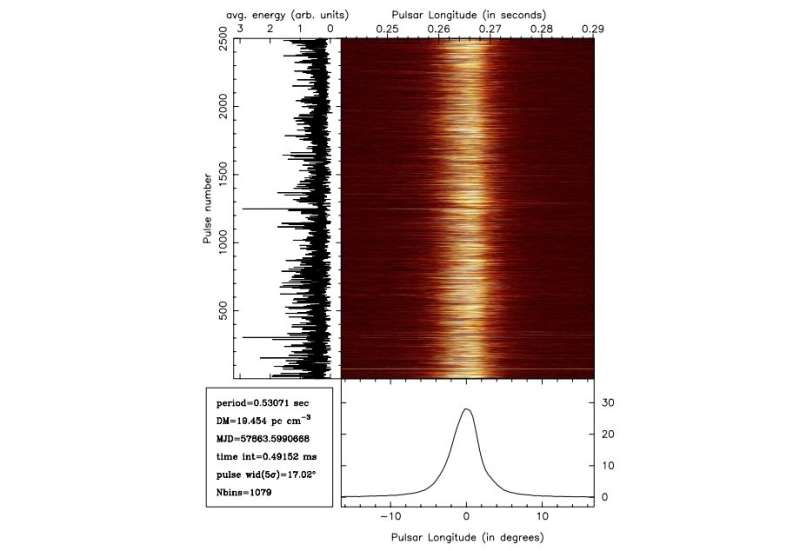August 20, 2018 report
Astronomers detect synchronous X-ray and radio mode switching of the pulsar PSR B0823+26

An international team of astronomers has detected synchronous X-ray and radio mode switching between radio-bright and a radio-quiet modes in the pulsar PSR B0823+26. The discovery marks the second time that such synchronous mode switching has been observed in a pulsar. The finding is detailed in a paper published August 6 on arXiv.org.
To date, synchronous X-ray and radio mode switching has been identified only in one old and nearly aligned pulsar known as PSR B0943+10. Therefore, astronomers are interested in finding such behavior in other objects in order to improve knowledge about the poorly understood mechanisms behind this activity.
The new study, conducted by a group of scientists led by Willem Hermsen of the University of Amsterdam in the Netherlands, presents another example of a pulsar experiencing synchronous X-ray and radio mode switching. The discovery was made as a result of observations with ESA's XMM-Newton spacecraft, the Giant Metrewave Radio Telescope (GMRT) in India and international stations of the Low-Frequency Array (LOFAR).
"We observed the radio-mode switching PSR B0823+26 for about 39 hours simultaneously in X-rays and the radio band and report the discovery of synchronous correlated X-ray and radio mode switching," the researchers wrote in the paper.
PSR B0823+26, located some 1,000 light years away from the Earth, is one of the brightest radio pulsars in the Northern sky. It has a period about 530 milliseconds, a spin-down age of approximately 4.9 million years and an inferred magnetic field of around 980 billion G.
The observations performed by Hermsen's team allowed the researchers to find that PSR B0823+26 switches between a radio-bright (B) mode and a radio-quiet (Q) mode. In particular, the pulsar was found to be in the radio B mode during five out of six XMM-Newton observations and in the Q mode during only one observation. Moreover, the pulsar spent only approximately 15 percent of the time in Q mode over entire radio observational campaign with GMRT and LOFAR.
Notably, during the Q mode, the researchers did not detect PSR B0823+26 in X-rays with an upper limit almost an order of magnitude lower than the reported flux in the B mode. They emphasized that this is a surprising result, as PSR B0943+10 is known to showcase anti-correlated mode switches.
The authors of the paper also try to explain the nature of the observed synchronous X-ray and radio mode switching in PSR B0823+26. They assume that at the moment, the most plausible hypothesis is that this behavior is due to variations in the rate of accretion of material from the interstellar medium through which it is passing.
"We are speculating that in PSR B0823+26, we are not seeing 'true' mode-changing but the sudden appearance of strong bursts whose intensities follow a self-similar (i.e. fractal) distribution over a wide range of timescales. Such a system could be identified as exhibiting self-organized criticality. In this context, we speculate that PSR B0823+26 is accreting material from a debris disk or the interstellar medium through which it is passing, to explain some of its X-ray characteristics," the astronomers concluded.
More information: Discovery of synchronous X-ray and radio moding of PSR B0823+26, arxiv.org/abs/1808.01901
Abstract
Simultaneous observations of PSR B0823+26 with ESA's XMM-Newton, the Giant Metrewave Radio Telescope and international stations of the Low Frequency Array revealed synchronous X-ray/radio switching between a radio-bright (B) mode and a radio-quiet (Q) mode. During the B mode we detected PSR B0823+26 in 0.2−2 keV X-rays and discovered pulsed emission with a broad sinusoidal pulse, lagging the radio main pulse by 0.208 ± 0.012 in phase, with high pulsed fraction of 70−80%. During the Q mode PSR B0823+26 was not detected in X-rays (2 σ upper limit a factor ~9 below the B-mode flux). The total X-ray spectrum, pulse profile and pulsed fraction can globally be reproduced with a magnetized partially ionized hydrogen atmosphere model with three emission components: a primary small hot spot (T∼3.6×106 K, R∼17 m), a larger cooler concentric ring (T∼1.1×106 K, R∼280 m) and an antipodal hot spot (T∼1.1×106 K, R∼100 m), for the angle between the rotation axis and line of sight direction ∼66∘. The latter is in conflict with the radio derived value of (84±0.7)∘. The average X-ray flux within hours-long B-mode intervals varied by a factor ±20%, possibly correlated with variations in the frequency and lengths of short radio nulls or short durations of weak emission. The correlated X-ray/radio moding of PSR B0823+26 is compared with the anti-correlated moding of PSR B0943+10, and the lack of X-ray moding of PSR B1822-09. We speculate that the X-ray/radio switches of PSR B0823+26 are due to variations in the rate of accretion of material from the interstellar medium through which it is passing.
© 2018 Phys.org



















